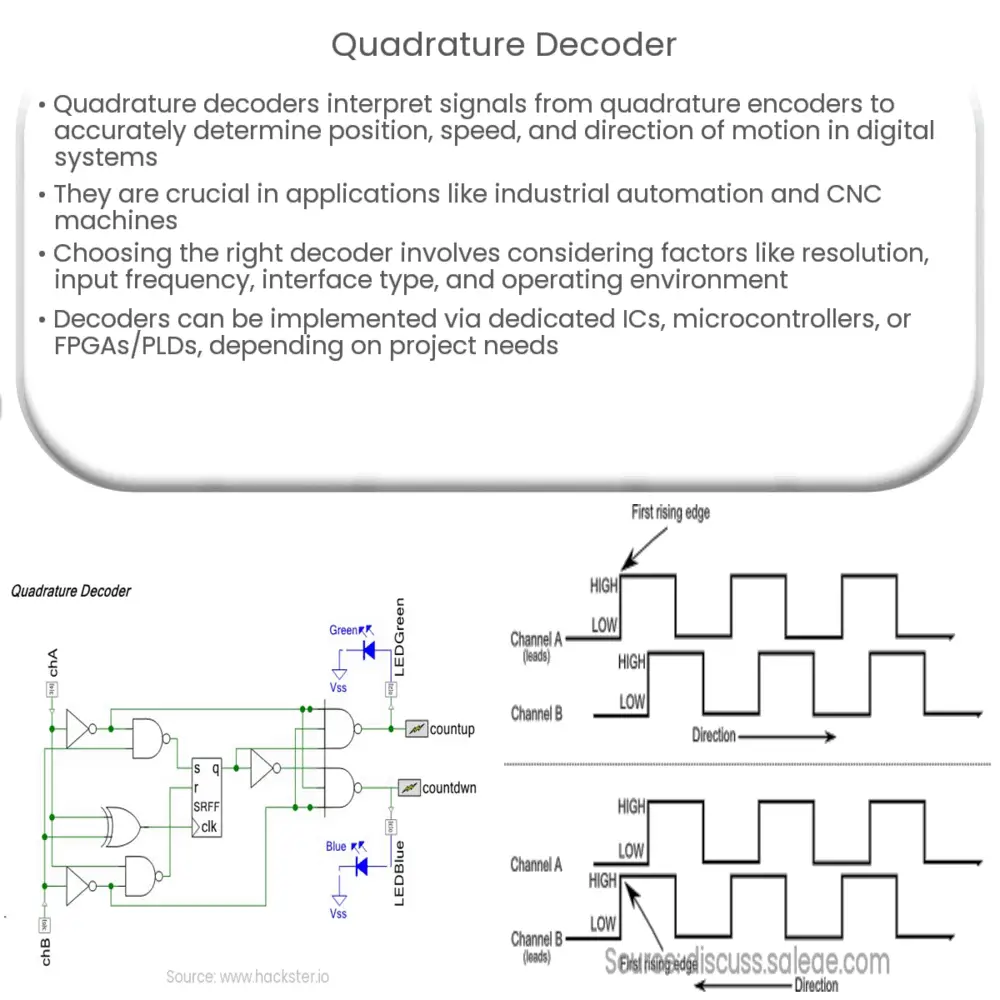A quadrature decoder interprets signals from quadrature encoders to determine an object’s position, speed, and direction with high precision.

Quadrature Decoder: A Comprehensive Introduction
Overview
A quadrature decoder is an essential component in many digital systems, particularly those involving motion control and measurement. It is responsible for interpreting the signals generated by quadrature encoders, which are typically found in rotary encoders or linear scales. By decoding these signals, a quadrature decoder can determine the position, speed, and direction of a moving object with remarkable precision. In this article, we will explore the working principles of quadrature decoders, their applications, and some key considerations when selecting a suitable decoder for your project.
Quadrature Encoders and Signals
Before delving into the specifics of quadrature decoders, it is important to understand the source of the signals they interpret: quadrature encoders. A quadrature encoder is a type of sensor that translates mechanical motion into electrical signals. This is achieved through a series of optical, magnetic, or capacitive sensing elements that generate two sinusoidal output signals, often referred to as channels A and B.
These channels are designed to be 90 degrees out of phase, which allows the quadrature decoder to discern the direction of motion based on the relative phase shift between channels A and B. The number of signal transitions (or pulses) per revolution or linear distance is known as the encoder’s resolution. A higher resolution translates to greater precision in motion control and measurement applications.
How Quadrature Decoders Work
Quadrature decoders are responsible for interpreting the signals from quadrature encoders to determine the position, speed, and direction of a moving object. They do this by continually monitoring the state of channels A and B and identifying the changes in their relative phase relationships. These phase shifts can be interpreted as incremental changes in position, known as counts.
There are four possible combinations of the A and B signals, which are referred to as the quadrature states. By tracking the transitions between these states, the quadrature decoder can determine both the direction and the incremental position change of the moving object. The speed of the object can then be calculated by measuring the time between successive state transitions.
Applications of Quadrature Decoders
Quadrature decoders are widely used in various applications that require precise motion control and measurement. Some common examples include:
- Industrial automation: Quadrature decoders play a crucial role in the precise control of motors, conveyors, and robotic systems in manufacturing facilities.
- CNC machines: These computer-controlled machines rely on quadrature decoders to determine the position and speed of their cutting tools or workpieces, ensuring accurate and repeatable machining processes.
- Laboratory equipment: High-precision instruments, such as optical encoders and linear actuators, employ quadrature decoders to maintain accurate positioning and motion control.
Selecting a Quadrature Decoder
When choosing a quadrature decoder for your project, several factors need to be considered to ensure optimal performance and compatibility. Some key considerations include:
- Resolution: The resolution of your quadrature encoder will dictate the level of precision required from your decoder. Make sure that the decoder you select can handle the encoder’s resolution to achieve the desired level of accuracy in your application.
- Input frequency: Quadrature decoders have a maximum input frequency, which represents the highest rate of signal transitions they can process. Ensure that the decoder’s input frequency matches or exceeds the maximum frequency of the quadrature encoder to avoid losing position information.
- Interface: Consider the type of interface provided by the quadrature decoder, as this will determine how it communicates with your system. Common interfaces include parallel, serial (e.g., RS-232, RS-422, or SPI), and bus-based (e.g., CAN, I2C).
- Operating environment: The environmental conditions in which the decoder will operate, such as temperature, humidity, and potential exposure to contaminants, can affect its performance and reliability. Select a quadrature decoder designed to withstand the specific conditions of your application.
Implementing a Quadrature Decoder
Quadrature decoders can be implemented using a variety of methods, depending on your project’s requirements and available resources. Common implementation options include:
- Dedicated ICs: Many integrated circuits (ICs) are specifically designed to function as quadrature decoders. These ICs offer a compact, efficient solution and are available with a wide range of features and specifications.
- Microcontrollers: Many microcontrollers have built-in peripherals, such as timers or counters, that can be used to implement a quadrature decoder in software. This approach provides flexibility and can be more cost-effective than dedicated ICs, especially for lower-resolution applications.
- FPGA/PLD: Field-programmable gate arrays (FPGAs) or programmable logic devices (PLDs) can be used to implement custom quadrature decoders with high resolution and performance. This option is well-suited for complex applications or those requiring a high level of customization.
Conclusion
Quadrature decoders are vital components in many motion control and measurement applications, providing precise information on the position, speed, and direction of moving objects. By understanding the principles of quadrature decoding and considering key factors when selecting and implementing a decoder, you can optimize your system’s performance and achieve accurate, reliable results in your application.

